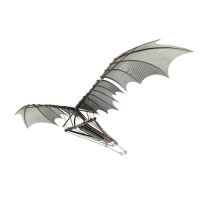Remaking Nature Click on the thumbnails to explore the trail
Read more about this trail (expand)
Leonardo’s ultimate aim was to imitate nature by remaking nature, as opposed to slavishly copying natural forms. This would require a profound understanding of the relationship between the effects of natural appearances and the underlying causes that gave rise to their form. Equipped with this knowledge, Leonardo believed he could create forms equitable to those found in nature, many of which might be of great service to man.

- Enlarge
- © Leonardo3 - www.leonardo3.net
Flying machine – Ms B Fol 74v-75r 1488-89
Leonardo’s earlier designs for flying machines were ornithopters, that is they had flexible wings based on the structure of birds’ wings.
This version of an ornithopter seeks to harness the physical power of the human body in the most efficient way possible. The pilot, who is in a horizontal position, activates the wings by pushing on the pedals with his feet. A series of cables running from the pedals to the wings instigate a complex series of movements. In addition to completing a rotatory movement, when the wings bend they make a flexing movement towards the centre. The result is a compound motion that imitates the movements of birds wings in flight closely.
Leonardo does not seem to have been aware that the feathers of birds’ wings twist on the downstroke, propelling it forward. Neither did he acknowledge that man did not have sufficient muscle power to emulate birds. Aware of the dangers of testing the machines he advised that it be tested over a lake, and a “long wineskin should be carried as a girdle, so that in the event that you fall you will not be drowned”.
In Leonardo's words
Bolt the upper hall and make a large and tall model; and you will have room on the upper roof…and if you stand on the roof, to one side of the tower, people in the ‘tiburio’ will not see you.
Leonardo studied mechanical wings for a long time and this is a reconstruction of one of the many projects for a flying machine documented in Manuscript B.
In his fascination with flying, Leonardo attempts to combine the dynamic potential of the human body with an imitation of natural flight. In his notes, he cites the bats, the kite and other birds as models to imitate. He refers to his flying machine as the “great bird”.
In the drawing for this flying machine Leonardo does not include the wings, as this is mainly a study of the mechanism for the folding of the wings. This occurs thanks to a system of pulleys and rods which is activated by the feet of the pilot.
The pilot lies supine on a wooden surface and sets the mechanism in motion by pushing two pedals with his feet in an alternating motion. The movement of the wings imitates bird flight.
For safety reasons, Leonardo suggests that the machine should be tested over a lake and places a floatation device under the structure to keep the machine from sinking if it falls on water.
- Location Bibliothèque de l’Institut de France












